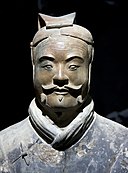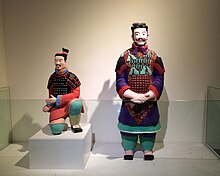Warrior figures
Types and appearance
The terracotta warriors are life-sized. They vary in height, uniform, and hairstyle in accordance with rank. Their faces appear to be different for each individual figure; scholars, however, have identified 10 basic face shapes. The figures are of these general types: armored infantry; unarmored infantry; cavalrymen who wear a pillbox hat; helmeted drivers of chariots with more armor protection; spear-carrying charioteers; kneeling crossbowmen or archers who are armored; standing archers who are not; as well as generals and other lower-ranking officers. There are, however, many variations in the uniforms within the ranks: for example, some may wear shin pads while others not; they may wear either long or short trousers, some of which may be padded; and their body armors vary depending on rank, function, and position in formation. There are also terracotta horses placed among the warrior figures.
Originally, the figures were painted with ground precious stones, intensely fired bones (white) and pigments of iron oxide (dark red), cinnabar (red), malachite (green), azurite (blue), charcoal (black), cinnabar barium copper silicate mix (purple), tree sap from a nearby source, (more than likely from the Chinese lacquer tree) (brown) and various other colors including pink, lilac and one unknown color. The coloured lacquer finish and individual facial features would have given the figures a realistic feel, with eyebrows and facial hair in black and the faces done in pink.
However, in Xi'an's dry climate, much of the animated color coating would flake off in less than four minutes after removing the mud surrounding the army.
Some scholars have speculated a possible Hellenistic link to these sculptures, because of the lack of life-sized and realistic sculptures before the Qin dynasty. They argued that potential Greek influence is particularly evident in some terracotta figures such as those of acrobats, combined with findings of European DNA in Xinjiang and rare bronze artifacts made with a lost wax technique known in Greece and Egypt. However, this idea is disputed by scholars who claim that there is "no substantial evidence at all" for contact between ancient Greeks and Chinese builders of the tomb. They argue that such speculations rest on flawed and old "Eurocentric" ideas that assumed other civilizations were incapable of sophisticated artistry and thus foreign artistry must be seen through western traditions.
Construction
The terracotta army figures were manufactured in workshops by government laborers and local craftsmen using local materials. Heads, arms, legs, and torsos were created separately and then assembled by luting the pieces together. When completed, the terracotta figures were placed in the pits in precise military formation according to rank and duty.
The faces were created using molds, and at least ten face molds may have been used. Clay was then added after assembly to provide individual facial features to make each figure appear different. It is believed that the warriors' legs were made in much the same way that terracotta drainage pipes were manufactured at the time. This would classify the process as assembly line production, with specific parts manufactured and assembled after being fired, as opposed to crafting one solid piece and subsequently firing it. In those times of tight imperial control, each workshop was required to inscribe its name on items produced to ensure quality control. This has aided modern historians in verifying which workshops were commandeered to make tiles and other mundane items for the terracotta army.





No comments:
Post a Comment